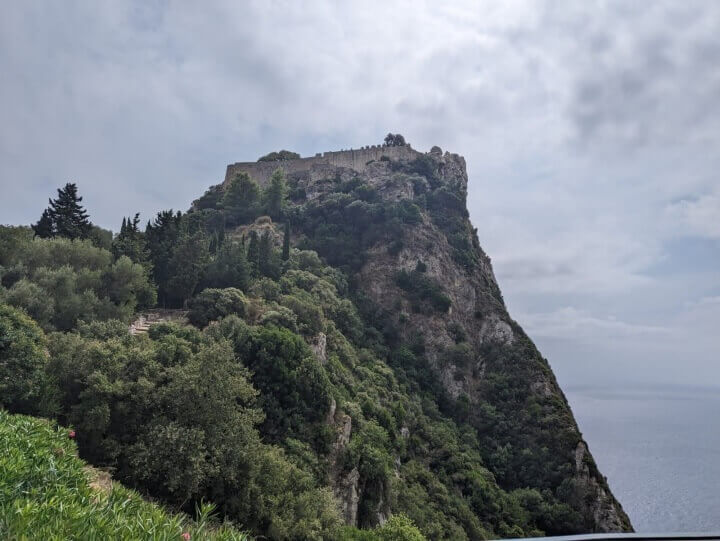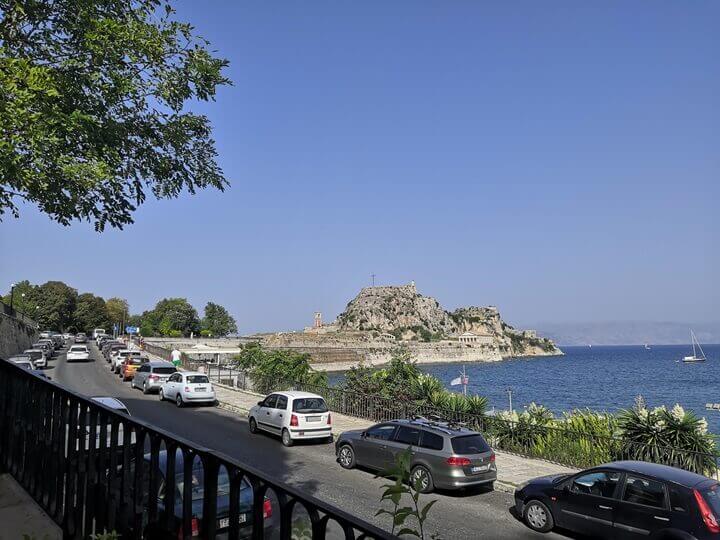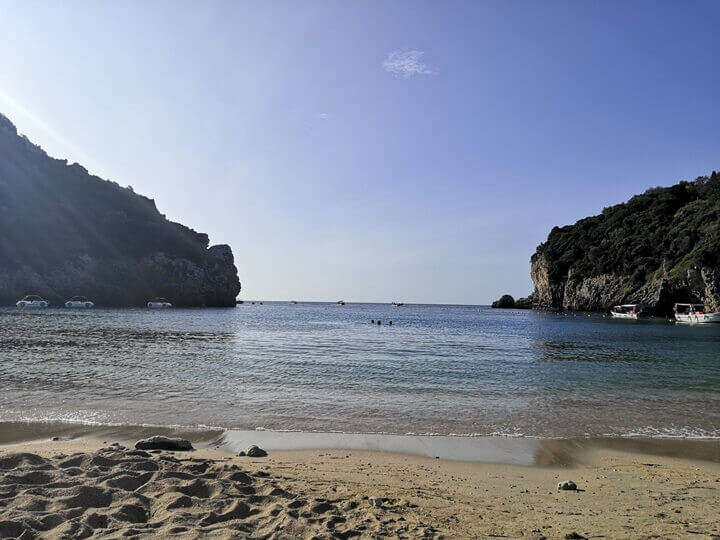Angelokastro Corfu: Ultimate Visitor’s Guide in 2024
Planning a trip to the beautiful Greek island of Corfu? I highly recommend adding Angelokastro to your Corfu itinerary.
One of the most significant historic sites on the island, it offers a glimpse into Corfu’s ancient past, as well as some of the most panoramic views. If you would like to see what the island offers beyond the beach, this is a great day trip option.
This article will provide an overview of what you can see on your visit to Angelokastro and the castle’s history. It also offers practical information on how to get there and the best places to stay for easy access to the castle.
A visit to Angelokastro was the highlight of my stay in northwestern Corfu. I hope this guide inspires you to experience it for yourself.
Disclosure: Some of the links below are affiliate links, which means that at no additional cost to you, I may earn a small commission if you click through and make a purchase. Please note, I only recommend products and services that I know and love. Read full Privacy Policy here.
Angelokastro, Corfu: Summary
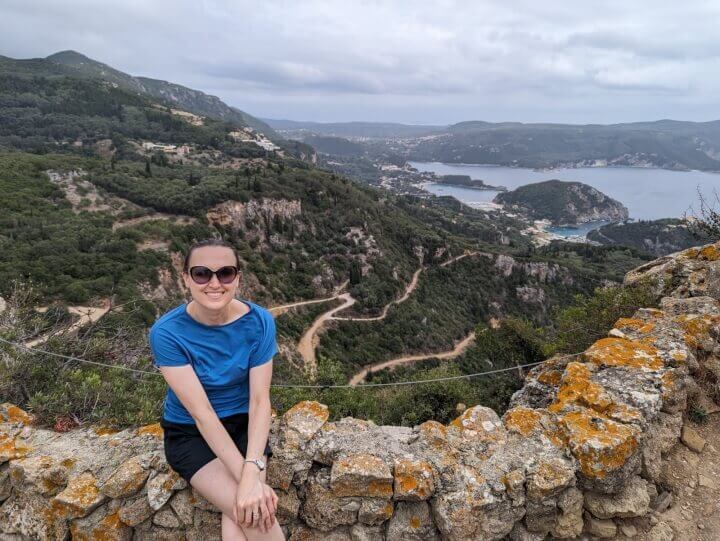
Located on a steep peak 305 metres above the sea on the northwestern coast of Corfu, Angelokastro is one of the island’s most iconic heritage sites. If you love history and incredible views, it’s absolutely worth a visit for a day trip.
Angelokastro is one of the oldest Byzantine castles in Greece. Kassiopi Castle in the north and Gardiki in the south of the island are other Byzantine fortresses on Corfu, but Angelokastro is the most significant and impressive.
Although today the castle lies in ruins, it remains a sight to behold. It sits atop a rugged cliff, offering 360-degree views of the surrounding terrain. A relatively steep and uneven path leads to the top of the castle, but you will be rewarded with breathtaking vistas along the way.
You can still see the remains of the protective walls, citadel, garrisons, and underground cisterns that once held the castle’s water supply when you visit. At the highest point of the citadel, you will find the small Church of Archangel Michael.
At the base of the hill on which the castle stands, there is a ticket office, a small car park, and a café. The entrance fee to Angelokastro is €3 (US $3.25) per person.
History of Angelokastro in Corfu
Although today only the ruins of Angelokastro remain, it was once a mighty fortress. It offered an excellent vantage point over the surrounding area, defending the island from constant sieges and pirate attacks.
Archaeological findings have revealed that the area where the castle stands has been inhabited by the early Byzantine period of the 5th-7th century. In the 11th century, Corfu became an important frontier for the Byzantine Empire as it lost its holdings in southern Italy.
It is believed that the castle was constructed in the 13th century by Michael I Komnenos Doukas, Despot of Epirus, also called Michael Angelos, who annexed Corfu in 1214 and further fortified by his son, Michael II Komnenos Doukas.
Later, in 1386, the castle fell to the Venetians, who continued the expansion and fortification of the castle, the remnants of which can still be seen today. The castle was instrumental in defending the island from frequent attacks from various conquering forces.
Angelokastro also played a significant role in the political life of the island under Venetian rule. It served as the capital of Corfu between the 14th and 16th centuries and the home of the governor of the Ionian Islands.
Nevertheless, as centuries passed and military strategies and technologies evolved, Angelokastro was gradually abandoned. The Venetian Republic fell in 1797, and Corfu changed hands a few more times.
In the 19th century, the castle was in ruins. Thankfully, restoration works started in 1999, allowing this incredible site to be enjoyed by visitors today.
How to Get to Angelokastro
Public transport in this part of Corfu is limited, so you will need to rely on different forms of private transportation or your own two feet to get to Angelokastro. This guide on the wider transport options in Corfu gives the complete lowdown on how to get around the island.
Hire a Car
The most popular way to get to Angelokastro is by car. Tourists can hire cars across many rental offices across the island.
The road leading to the castle will take you through the small village of Krini that has a few traditional tavernas and shops. There is a car park in Krini which is a 15-minute walk away from the castle.
Alternatively, you can keep going past Krini to reach the car park right at the foot of the castle. Be careful, the roads are narrow and winding, so go slow and always pay attention to what’s happening around you.
Private Transfer/Tour
If you prefer not to drive, you can arrange a private transfer to Angelokastro from another Corfu location. This option is pricey, but it does remove the hassle and stress of driving.
You can visit your local tourist information office to arrange a transfer. The office will help arrange a private driver and also suggest any other stops you may want to include as part of your journey to make the experience into a tour.
It’s also possible to book a transfer online – there are many different providers on the island. I usually go for Welcome Pickups as I’ve always had positive experiences with them.
The price will ultimately depend on the length of your journey. For example, if you are travelling to Angelokastro from Corfu Town, the trip will cost around US $70/£55.
A trip from the south of the island might cost about US $318/£250, which is not really a good option. You might as well hire a car.
Walk
This is my personal favourite way of getting to Angelokastro, as it allows you to fully appreciate the beautiful scenery around you. You can hike to the castle from various points in northwestern Corfu.
However, the route I recommend starts in the coastal town of Paleokastritsa, located 10 kilometres from Angelokastro. You can even see the castle from some of the beaches there.
Paleokastritsa to Angelokastro Route
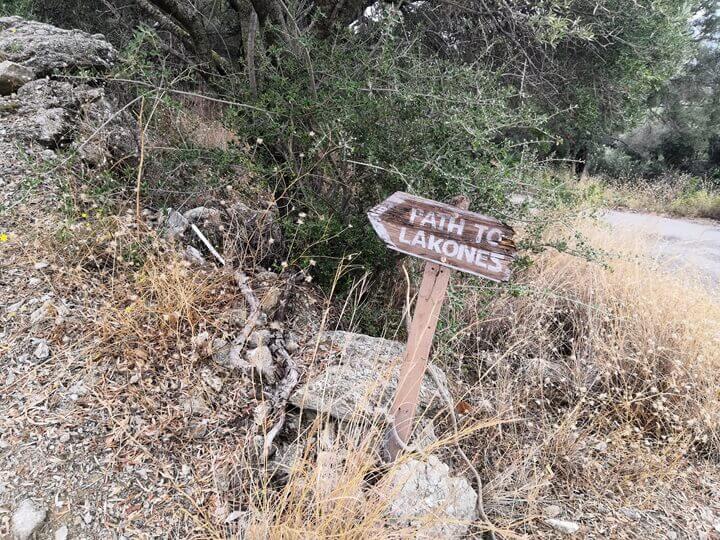
The journey begins at the bottom of the steep donkey trail leading to the quaint mountain village of Lakones. The entrance to the trail is signposted and located just past Ipsia Apartments.
The donkey trail is scenic and takes you through olive groves, providing some valuable shade during the journey. The path can be quite steep, so a good level of fitness is required to tackle it.
Once you reach Lakones, you’ll be rewarded with some great views. Take a break at one of the traditional local cafes, many of which have outdoor terraces offering spectacular vistas.
After a pit stop in Lakones, continue along the main road towards the Bella Vista point. Be cautious of passing cars when walking through the village, as the road is quite narrow.
Bella Vista lives up to its name, offering incredible views. There are also a couple of restaurants there if you’d like to grab lunch.
The next stop is the village of Makrades. The road here is relatively flat, a welcome change after the intense ascent of the donkey path.
Once you pass Colombos Taverna, turn left and walk towards the village of Krini. From there, it’s just a 20-minute walk to Angelokastro.
The one-way journey takes about two hours without any stops. I personally enjoyed the level of challenge it offered, but it’s not suitable for everyone.
Best Time to Go to Angelokastro, Corfu
The tourist season in Corfu runs from early May to the end of October. July and August are the hottest months, with average temperatures in the low thirties.
The heat can become quite intense, so it’s not necessarily the best time for any strenuous walks, unless you head out early in the morning. Also, this is the busiest period, and popular spots like Angelokastro can become crowded.
Personally, I believe early May and late September are some of the best times to visit Angelokastro and Corfu in general. The weather is still fantastic, but without the oppressive heat, and the crowds are less intense.
It’s possible to visit Corfu out of season, between November and April. However, be aware that many hotels and restaurants close during this period, so be sure to plan your trip in advance.
Additionally, Corfu receives significant rainfall during the winter, which might affect your experience of hiking to Angelokastro or enjoying the views from the top.
Where to Stay Near Angelokastro
My personal favourite place to stay near Angelokastro is Paleokastritsa. This popular resort town boasts several beautiful beaches, small family-run hotels, and a selection of great Greek restaurants.
As I’ve previously mentioned, Paleokastritsa can be a starting point for the donkey path that leads to the village of Lakones, from which you can continue on to Angelokastro.
Therefore, if you wish to include this adventure in your itinerary, staying there makes sense. Plus, it’s easy to get there from Corfu Town where most visitors start their island adventure.
If you’re considering staying in Paleokastritsa, I recommend Zefiros Traditional Hotel. It’s an affordable, family-run hotel right next to Agios Spiridon, the main beach in Paleokastritsa. It retains its historic charm and offers delicious breakfast options.
If you prefer to stay even closer to Angelokastro, the nearby villages of Krini and Makrades offer a small selection of self-catering accommodations, including charming villas.
Organised Tours Including Angelokastro
If you would rather have someone else organise the logistics of your trip, there are a couple of organised tours you can join to visit Angelokastro.
The first option is a guided group hike that combines a visit to the castle with trips to local mountain villages. This tour includes some steep sections, so it’s ideally suited for those with a good level of fitness.
The other tour is private and includes visits not only to Angelokastro but also to other iconic Corfiot sites, including the Mon Repos Palace in Corfu Town, Paleokastritsa, and Lakones.
- Corfu: Angel Castle Guided Hike and Sunset – from US $70.50/£50.60 per person
- Corfu Full-Day Private Sightseeing Tour – from US $241.45/£190.40 per person
Final Thoughts
So now you have all the information you need to visit Angelokastro. It’s an excellent day trip option for those looking to experience Corfu beyond the beach.
If you are in the planning stages of your trip to Corfu, do check out this guide to the costs on the island. I’ve found that Corfu is more affordable than many other popular Greek islands.
Also, Corfu is a safe destination with low crime rates, making it unlikely to encounter any unpleasant incidents, which further enhances its appeal.
For itinerary ideas for different trip durations, check out this guide on how many days in Corfu you need for a fulfilling trip.
FAQs: Angelokastro, Corfu
The literal translation of Angelokastro is ‘Castle of Angels’. The word ‘Angelos’ means ‘angel’, and ‘kastro’ translates to ‘castle’. An alternative interpretation is ‘Angelos’ Castle’. In the 13th century, Michael II Komnenos extended the castle and named it after his father, Michael Angelos.
Corfu is a famous travel destination known for its beautiful beaches and relative affordability. It has been popular with both package and independent tourists for many decades. The island is also home to Corfu Town, a UNESCO World Heritage Site. Here, you can feel as though you’ve travelled back in time, thanks to its authentic historic architecture.
Before Corfu became part of Greece in 1864, it was under British rule. However, Corfu has changed hands many times over the centuries. Thanks to its strategic location in the Ionian Sea, various peoples, including the Romans, Byzantines, Venetians, and the French, sought control over it.
The Greek name for Corfu is Kerkyra, which has its origins in Ancient Greek mythology. Kerkyra, or Korkyra, was a Naiad Nymph and the daughter of Asopos, the River God of Sikyon. According to legend, she was so beautiful that Poseidon, the god of the sea, fell in love with her and abducted her. He took her to an island in the Ionian Sea and named it after her.
Enjoyed this article on Angelokastro in Corfu? Bookmark or pin it for later.

Related Reads: Corfu
- Is Corfu Worth Visiting? 15 Great Reasons to Visit in 2024
- Is Corfu Expensive in 2024? The Ultimate Corfu Prices Guide
- Corfu in September: Everything You Need to Know in 2024
- Is Corfu Safe to Visit in 2024? The Ultimate Guide
- How Many Days in Corfu Do You Need for a Great Trip
- Corfu Without a Car: The Ultimate Guide 2024
- The 15 Best Villas in Corfu with Private Pool in 2024
- Is There Uber in Corfu in 2024? Everything You Need to Know
- The 10 Best Corfu Day Trips in 2024
- One Day in Corfu Town: The Ultimate Itinerary
- The 14 Best Things to Do in Paleokastritsa, Corfu in 2024
- Corfu Town to Paleokastritsa: Complete Guide 2024
- The 7 Best Restaurants in Paleokastritsa, Corfu in 2024

